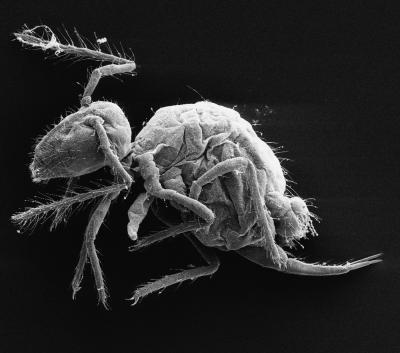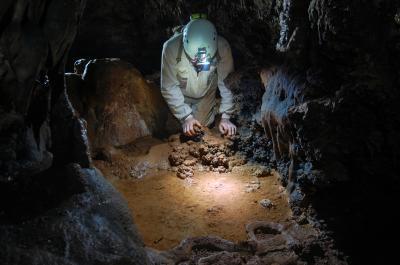Three new collembolan species have been discovered in the Maestrazgo caves in Teruel, Spain. Their description has been published in the Zootaxa journal and belong to one of the most ancient animal species on the planet.
The Maestrazgo caves in Teruel are located in a region of the Iberian Range. It is an isolated region with average altitudes between 1,550 meters and 2,000 meters above sea level and and a climate only the Scottish could enjoy, with temperatures ranging from -40°C to -25°C. Inside the
Maestrazgo
caves, the temperatures are a more hospitable 5-11°C.
These animals are arthropods from the hexapod group (meaning six legs), a parallel group to insects. However, they are different and more primitive, showing absence of wings, different structure of their mouth, presence of the ventral organ and frequently, presence of the springing organ named the furca (an uneven abdomen appendix used to jump far away from danger).

Pygmarrhopalites maestrazgoensis. Credit: Rafael Jordana, Enrique Barquero
The three new species of collembolan belong to very different groups and are phylogenetically separate from one another. They have been named Pygmarrhopalites maestrazgoensis, P. cantavetulae and Oncopodura fadriquei. The researchers have also found specimens of five other species in the caves that have already been documented in nearby and further away caves.
"Studying fauna in the caves allows us to expand on our knowledge of biodiversity. In the case of the three new collembolan species that we have found in Teruel, they are organisms that have survived totally isolated for thousands of years. Having 'relatives' on the surface means they act like relics from the past that have survived the climate change taken place on the outside of the caves," the University of Navarra's Enrique Baquero, who carried out a taxonomic study along with Rafael Jordana, told SINC.
These animals were found by a team of speleologists headed by Floren Fadrique from the Catalan Association of Biospeleology. They entered different caves in harsh conditions of cold, humidity and darkness. It is vital to study how new species found adapt to the cave environments. "Like other cave-adapted animals, the collembolans require greater chemical sensitivity as they cannot use their sight in the absence of light," explains Baquero.

The Espeologos team during the descent into the cave. Credit: Floren Fadrique
The expert concludes that "the animals were captured by laying down traps. These consisted of jars containing different liquids, which the animals approached in search of food. They were then trapped until the speleologists returned to collect them. Professor Jordana and I received the samples collected by the speleologists and proceeded to their identification."




Comments